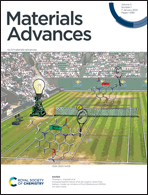van der Waals graphene/MoS2 heterostructures: tuning the electronic properties and Schottky barrier by applying a biaxial strain
Abstract
First principles calculations are performed to study the effects of the interlayer distance and biaxial strain on the electronic properties and contact properties of graphene/MoS2 heterostructures. The interlayer interaction is weakened and the charge transfer from the graphene layer to the MoS2 layer is reduced with increasing interlayer distance in graphene/MoS2 heterostructures, resulting in a shift of the Fermi level to a high energy state. The n-type Schottky barrier is formed with ΦSB,N values of 0.647 eV, 0.568 eV, 0.509 eV, and 0.418 eV when the interlayer distances are 3.209 Å, 3.346 Å, 3.482 Å, and 3.755 Å, respectively. The interlayer distance and charge density difference change slightly, but the electronic structure of the graphene/MoS2 heterostructure changes obviously by applying the biaxial strain. For the biaxial strain from −4% to +6%, the ΦSB,P gradually increases for the graphene/MoS2 heterostructure, while the ΦSB,N increases initially and then decreases. Moreover, the ΦSB,N is only 0.080 eV under a biaxial strain of +6%, indicating that the Ohmic contact is nearly formed. The results demonstrate the significant effects of a biaxial strain on the physical properties of 2D heterostructures.



 Please wait while we load your content...
Please wait while we load your content...